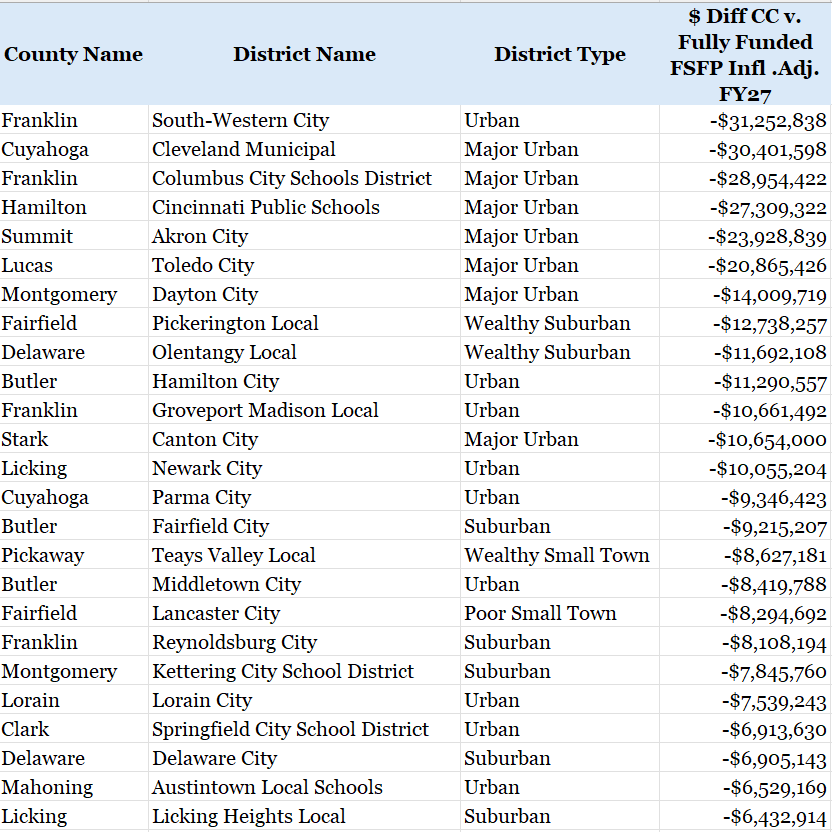State Budget Robs Poor Kids to Overfund Rich Adults
By doubling down on an unconstitutional voucher program, state legislature and Gov. DeWine overfund wealthy students while cutting money to poor students
Now that the dust has settled, let’s look at how the state’s school funding budget ended up, shall we?
First of all, it’s important to recognize a few things:
Ohio’s Fair School Funding Plan fails to be fully funded. The state added some arbitrary funding amounts to help out wealthier, mostly suburban school districts, but that money isn’t tied to anything rational. It’s just some number they came up with out of mid-air.
The total shorted funding for kids in school districts in the 2026-2027 school year that will receive less than what the Fair School Funding Plan says they need will be about $950 million less, if the state actually included simple inflationary increases to the plan from 2022 — as the original plan promised to do so it would keep pace with the actual costs of educating kids.
You’ll never guess how much EdChoice will cost in the 2026-2027 school year. Just about $950 million — the nearly perfect 1:1 transfer of funding that led Franklin County Common Pleas Judge Jaiza Page to rule June 24 that EdChoice was unconstitutional.
The Ohio General Assembly did exactly what Congress did recently — create a massive wealth transfer from poorer school districts to wealthier ones.
So let’s look at this in more detail.
Overall, state aid in the 2025-2026 school year will go from $8.4 billion to $8.5 billion, then from $8.5 billion to a little more than $8.6 billion. A fully funded Fair School Funding Plan based on 2022 costs would cost $8.75 billion. A fully funded Fair School Funding Plan based on inflation adjusted 2022 costs would run $9.4 billion1.
So on a statewide basis, the FSFP is about $800 million of what it actually costs today. However, here’s something interesting: That $800 million includes 166 districts that are receiving more than the Fair School Funding Plan would provide because the state is arbitrarily providing additional money based on test scores and other random items, which is intentionally geared to improving the funding in wealthier districts.
If you check the amount that the state is short in districts that receive less than what a fully funded, inflationary adjusted FSFP provides, the state is $957 million short in those 443 districts. So this plan is literally underfunding students in our poorest school districts in order to overfund students in wealthy ones based on arbitrary, calculations designed to steer more money into wealthier districts.
Amazingly, 7 of the top 12 districts in terms of total funding shortfalls are the state’s Major Urban districts. And there are only 8 of those — Akron, Canton, Cincinnati, Cleveland, Columbus, Dayton, Toledo and Youngstown. Likewise, while 20 percent of the state’s 47 urban districts show up in the top 25 biggest losers, only 4 percent of the state’s 46 wealthiest suburban districts do.
Here are the 25 districts that are shorted by the most money under the state’s just passed budget:
Oh, and should I mention that the amount those students in the 443 districts that are being underfunded is just about the same amount of money as the unconstitutional EdChoice Voucher program is set to be funded next year?
These guys. They just can’t help themselves. If they eliminated the unconstitutional EdChoice Vouchers, they could properly fund kids in our poorest districts and still overfund kids in wealthy ones!
But they just can’t keep screwing kids and families in less wealthy Ohio communities so kids and families in wealthier communities can get more money than the state says they need, or have their private school tuition subsidized in large part by those same families living in poorer communities.
Sick, man.
Sick.
I should mention that these are estimates. When the Conference Committee released their district-by-district funding runs, they included all funding going to the district, not just the funding being sent by the Fair School Funding Plan. So I took the difference between what the Fair School Funding Plan provided this school year and what it should have provided. I then added that difference to what the Conference Committee calculated as this year’s total state funding to find out what a fully funded Fair School Funding Plan would have provided this year on the Conference Committee simulations, which came out to $8.75 billion. I then subtracted how much the Conference Committee provided in the 2025-2026 and 2026-2027 school years from what a fully funded Fair School Funding Plan would have provided this school year to come up with the difference. I also multiplied this year’s funding, if they had fully funded the Fair School Funding Plan and adjusted it according to the inflationary increase from 2022, which was the last time the inputs were calculated. That was a 9 percent bump. The amount needed is likely more because the adjustments weren’t just inflationary; there were new special ed, poverty and other calculations too. But I just wanted to be as conservative as possible with the estimate.




